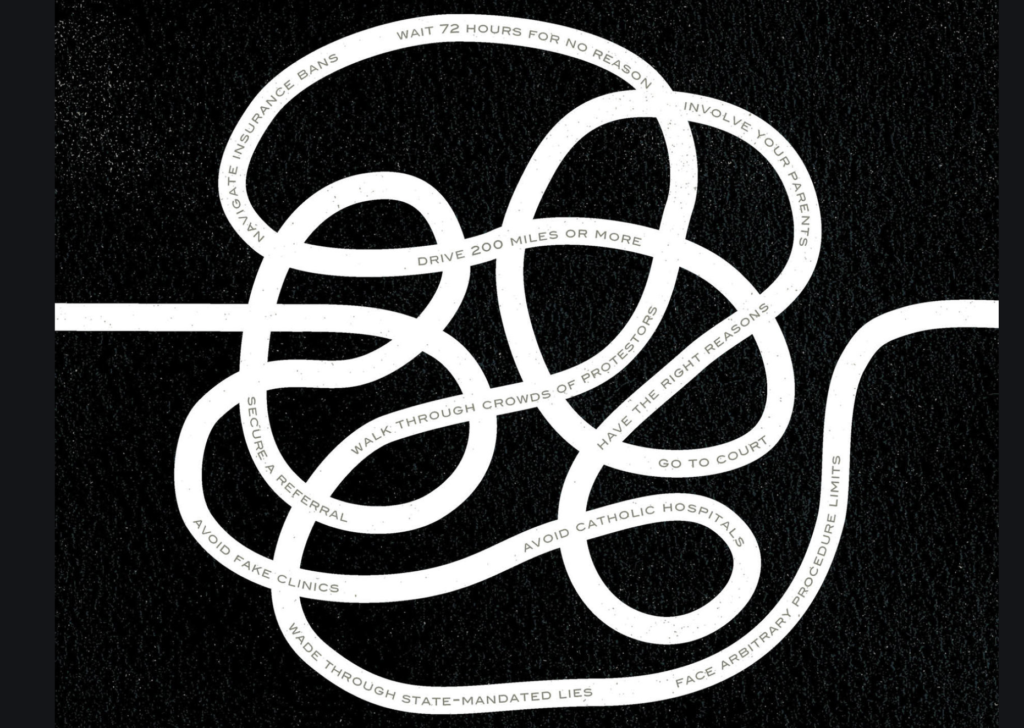For almost half a century, every American woman has had the constitutional right to an abortion.
But—as U.C. San Francisco sociologist Carole Joffe and Drexel law professor David S. Cohen show in their new book, Obstacle Course: The Everyday Struggle to Get an Abortion in America—the reality of exercising one’s reproductive rights is riddled with hurdles designed by anti-abortion activists and politicians.

Even those who are ardently pro-choice rarely understand the layers of logistical, financial, informational and emotional difficulty intentionally added to the process of terminating an unwanted pregnancy in the United States.
Through interviews with abortion providers in all 50 states, D.C., and Puerto Rico, as well as dozens of personal stories, Joffe and Cohen show the myriad roadblocks that women—especially those who are poor, minorities and from Republican-dominated states—must navigate to get an abortion, from the moment they face an unwanted pregnancy to the actual procedure itself.
One teen spotlighted in the book is lied to by a “crisis pregnancy center.” Another woman is harassed at a clinic by protesters throwing doll parts covered in fake blood. An undocumented, uninsured woman carrying a fetus with a devastating chromosomal disorder is forced to rely on clinic discounts, charitable funding and a rotating team of numerous volunteers to drive her across multiple state lines over several days, and still she was forced to pay thousands out of pocket.
Over 850,000 abortions are conducted annually in America, and the procedure is safer than childbirth, a colonoscopy and liposuction. In fact, there’s no other medical procedure with the same level of risk treated in a remotely similar way.
In the interview below, Cohen and Joffe break down the motivation behind the book, the process of writing it, the reality of anti-abortion extremism and the best path forward.
There are a lot of surprising details in Obstacle Course about the sheer number and variety of hurdles anti-choice activists and legislatures have enacted to prevent women from getting abortions. When did this become the go-to strategy for anti-choicers?
The barriers that we detail in Obstacle Course have a long pedigree, going back to shortly after Roe v. Wade. In 1976, Congress passed the Hyde Amendment, which forbids the use of federal dollars for abortion except under very limited circumstances. Parental notification and consent laws came fairly soon after that.
However, the 1992 Supreme Court decision in Planned Parenthood v. Casey, though it reaffirmed much of Roe, opened the door to a wide variety of restrictions. So-called TRAP laws—which stands for “targeted restrictions of abortion providers”—began to appear in the 1990s; these included things like hospital admitting privileges and ambulatory surgical center (ASC) laws, expensive and onerous demands that freestanding clinics upgrade to the specifications of hospitals.
More recently, the 2010 midterm elections, widely understood as a backlash to President Obama, increased Republican control in many state legislatures and led to a flood of new restrictions. Altogether, there have been more than 1200 restrictions passed since Roe, and more than a quarter of these have been since the pivotal 2010 election. The Supreme Court’s 2016 case Whole Woman’s Health v. Hellerstedt—which invalidated Texas laws regarding hospital privileges and ASC requirements—theoretically meant many other restrictions would be unconstitutional because the Court required abortion laws to be supported by research showing their benefit.
However, a case currently before the Court, June Medical v. Gee, is considering hospital privileges anew—leading to deep concerns within the abortion-providing community that the newly-conservative Supreme Court will change course. After several states recently passed draconian anti-abortion laws, there was a lot of attention paid to the largely white and male makeups of their legislatures.
How would abortion in America be different if there were more women or people of color in power?
People of color have been among the leading defenders of abortion rights in a number of states recently, especially “red” ones such as Alabama and Georgia. In some cases, white women have also been leading defenders of abortion—but, in other cases, they have also very outspoken proponents of anti-abortion laws.
Given the parties’ polarization around abortion, in order to really see a change, the greatest hope for a more abortion-friendly environment in state and local legislative bodies rests more on which political party is in control—as opposed to the gender or race of the legislators. That is, real change in a pro-choice direction can only occur if there are more of these legislatures under Democratic control and less under Republican control.
We experienced an example of this in the 2018 elections: the gains made by Democrats in several 2018 governor’s races, e.g. Michigan, Kansas, Wisconsin, have been consequential in holding back restrictions.
If the Supreme Court overturns Roe v. Wade and it becomes a states-rights issue, what will be the most immediate and obvious changes?
The most immediate change, should Roe be overturned, will be an intensification of activities already in motion as so many Americans already live in a post-Roe environment, like those living in states with only one clinic, or with no clinic that is able to give the specialized care some women need.
The vast array of volunteers’ efforts we document in Obstacle Course—raising money to pay for people’s abortions, as well as their travel from “hostile” states to “haven” ones, and lodgings—will need to be ramped up because abortion will immediately be illegal in some states and might become illegal in others in the near future. Through extraordinary efforts, many people will still be able to obtain their abortion, but many others won’t.
Should Roe be overturned, there will also likely be an increase in “self-managed abortion”—people attempting their own abortions by various means—a phenomenon already well underway in the United States, particularly in states where access is difficult. Much of this self-managed activity will take place via medication abortion drugs ordered over the Internet or brought into the U.S. from countries where these medications are more readily available.
Encouragingly, the use of these drugs is more effective and far safer than the proverbial coat hanger and other dangerous methods associated with self-managed abortion of the pre-Roe era. However, there is reason to fear that legal scrutiny of those attempting self-managed abortion and those that help them will be greater than in the earlier period and may result in prosecution and imprisonment.
It seems like the right is “winning” the battle on abortion right now. Is there any reason for hope?
Yes. As red states become more restrictive, a number of blue states are taking proactive steps to protect abortion rights. In the past year, we’ve seen states change their laws to guarantee a right to abortion. Other states have expanded Medicaid coverage to include abortion, as well as expanded the list of medical professionals who can provide abortions. Some cities have joined the effort too, with New York and Austin allocating funds to cover abortions for those who can’t afford them. The red states that are trying to ban abortion get most of the media attention—but pro-choice states are fighting back and doing everything in their power to preserve and expand access in the face of a hostile national landscape.
You describe a number of “crisis pregnancy centers” in the book that essentially masquerade as medical centers—they have similar names and signs, staff dressed in scrubs, and are located next door to or nearby real clinics. They offer coercive and medically unsound information in an effort to get them to decide not to abort their pregnancy. How is this legal? What can people do to combat this practice?
Unfortunately, the Supreme Court has ruled on this in a way that makes combatting these deceptions difficult. California tried to force these fake clinics to disclose information about real medical services, but the Supreme Court ruled that doing so violated the fake clinics’ free speech rights. Thus, they are virtually free to lie and trick patients. There are still options to combat these clinics—increase awareness of what they are, restrict state and federal dollars from going to them, and modifying false advertising and deceptive business practice laws to cover them. Fake clinics are not the biggest obstacle to patient access to abortion, but they do contribute to the web of barriers patients face.
How much of the volunteer network that assists women seeking abortions is driven by women who lived in America before Roe V. Wade?
Some of those who volunteer are of the pre-Roe generation, but our research has made clear that those who provide escorting and other services at their local clinics and those who volunteer for abortion fund work are truly multi-generational and multiracial. The evolution of an earlier “reproductive rights” movement into a broader “reproductive justice” movement that vigorously supports abortion but also supports the right to conditions that support healthy pregnancies and childrearing has brought many younger women into prochoice circles that were long populated heavily by women of the pre-Roe era.
Donating to Planned Parenthood, Abortion Care Network or NARAL and volunteering as a clinic escort are helpful, but beyond voting for pro-choice candidates, what’s the best way for individuals to help secure reproductive rights on a legislative and judicial level?
We see electoral work—at the state and local levels, not just at the national level—as crucial. This means not only voting every four years for President, but also during every single election you can—primaries and generals, local and state. If you’re not voting in every election, you’re doing it wrong.
But there’s much more beyond voting—helping to recruit and support pro-choice candidates, getting others registered to vote—then making sure they do vote! Nothing will change in the United States with respect to the continual attacks on abortion until the pro-choice majority (a majority reinforced continually in polls) votes on this issue with the same discipline and regularity as opponents of abortion.
Other important activities include being willing to testify at local and state forums against bad laws (or in favor of good ones), writing op-eds and letters to your local newspaper and joining local reproductive justice groups to participate in local activity addressing your community’s specific needs.





